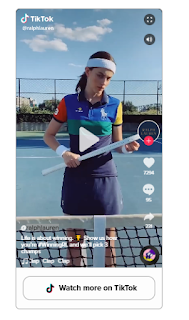2019 was the year TikTok truly exploded as both a
social and video platform. If you are under 30 years old, chances are you have probably
at least heard of the app even if you are unaware of what it actually is. For
those that don’t know what it is, the platform lets users upload videos that
last up to 15 seconds or allows users to combine a number of clips to produce
longer posts. The app has become extremely popular with videos of lip-synching,
dance routines, animals, challenges, comedic skits, and a variety of other things
that would be too numerous to count.
Since launching worldwide in 2017, the app has
grown at a staggering rate globally. For context, the U.S. market, which is still relatively small for TikTok, has about 26 million monthly active users according to a recent Wall Street Journal article (cited from App Annie Inc., a mobile data and
analytics firm). This is a growth rate of approximately +85% vs. a year earlier.
An article I read recently on eMarketer seems to suggest that growth rates like these may not be a sure bet in 2020. One of the big reasons why the eMarketer article casts doubt on this growth rate in active users being sustainable is the heightened competition that TikTok will face. As mentioned in the article, Tiktok will encounter startups like Firework to the legacy players such as Instagram and Facebook. The article argues:
Instagram is a particularly large threat; it recently added new tools to its Boomerang looping-effect feature that mimic similar features on TikTok. It's also testing a TikTok clone called Reels in Brazil.
Outside of competition, the article also raises the privacy and security issues through the lens of the US investigation of Tiktok's Chinese ownership and understanding as to how Tiktok's data is handled. The thought is that the investigation in itself could be enough to make current users more cautious about how they use the app while potentially dissuading potential new users from joining.
Lastly, the article demonstrates that in the U.S., interest is still quite small when gauging against all internet users. According to a study done in October by CivicScience, 49% of internet users age 13 and older said they were not interested in TikTok. When looking at just the teen demographic, usage is much stronger with 45% of teens aged 13-17 having used the app in the past month.
This is a big reason why over the past 6 months alone, numerous brands (including Ralph Lauren and Uniqlo) have sponsored their own their own challenges on the platform in an effort to connect and draw in Gen Z consumers. Ralph Lauren, for example, debuted on the app during the US Open in August and became the first brand to launch a hashtag challenge campaign on the platform that was tied to a sporting event. Users were encouraged to create videos similar to the clips uploaded by the brand while using the hashtag #WinningRL (with all users entered to win Ralph Lauren swag in the process). According to Vogue Business, the campaign's hashtag drove over 700 million views.
As more and more brands decide to engage on TikTok in an effort to win potential younger consumers, I think it will be interesting to see not only if brands are able to garner these views, but if they are actually able to turn it into actual traffic (whether to stores or online). Despite the large number of active users, getting those views to be consistent also seems to be a challenge. As an example, while Ralph Lauren's campaign hashtag drove over 700 million views, they have 3,331 followers as of today on TikTok. As of now, there doesn't seem to be any material indication yet that brands have been able to effectively utilize the platform to drive high returns on investment. With that said, it is still early and will require monitoring as more retailers and brands experiment with shifting marketing spend here.
WSJ article - https://www.wsj.com/articles/tiktok-tightens-rules-on-video-content-and-users-11578510808
eMarketer article - https://www.emarketer.com/content/tiktok-had-a-banner-year-in-2019-but-growth-in-2020-isnt-a-sure-bet
Vogue Business article - https://www.voguebusiness.com/companies/tiktok-social-networking-video-app-gen-z-mac-ralph-lauren


No comments:
Post a Comment